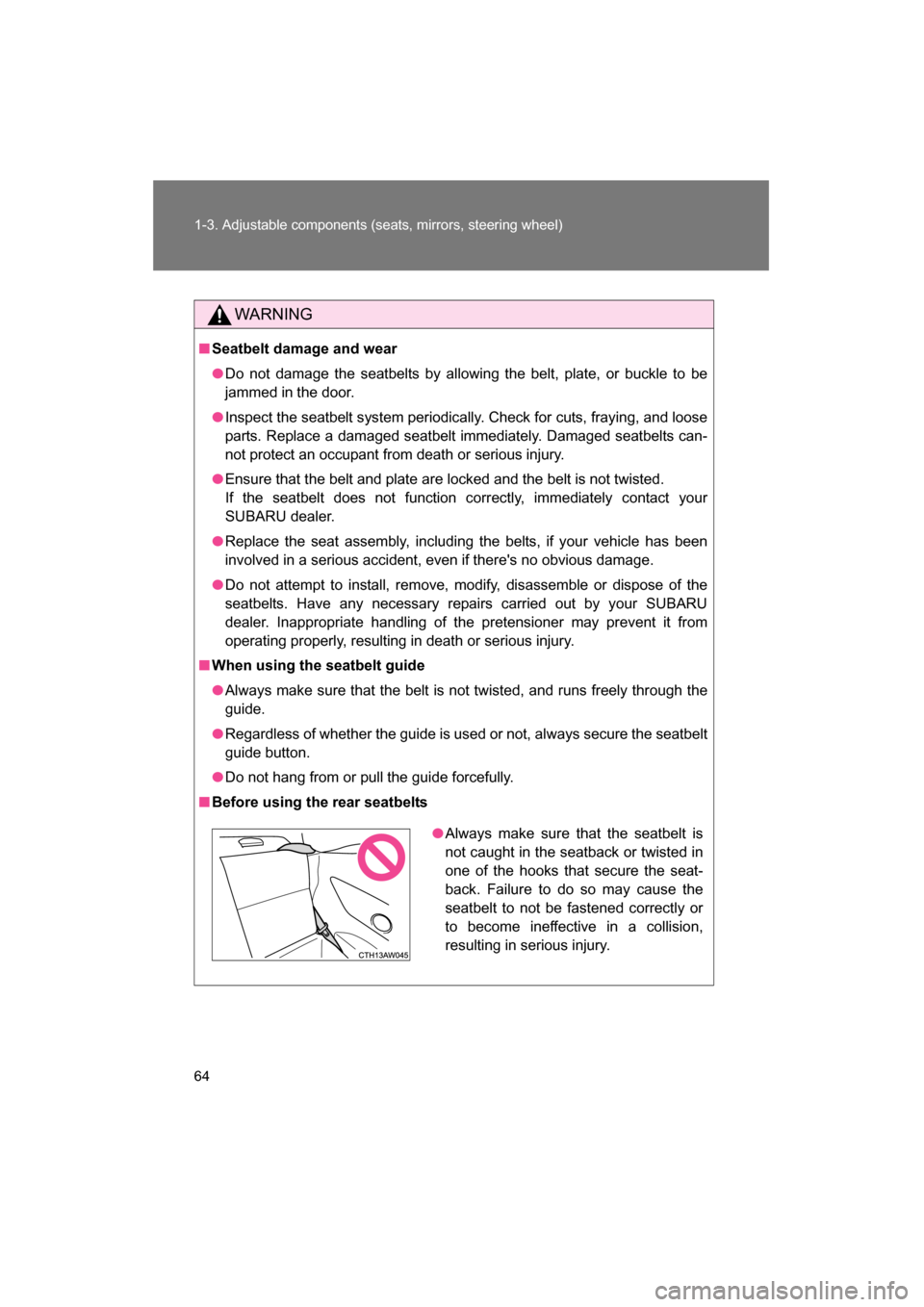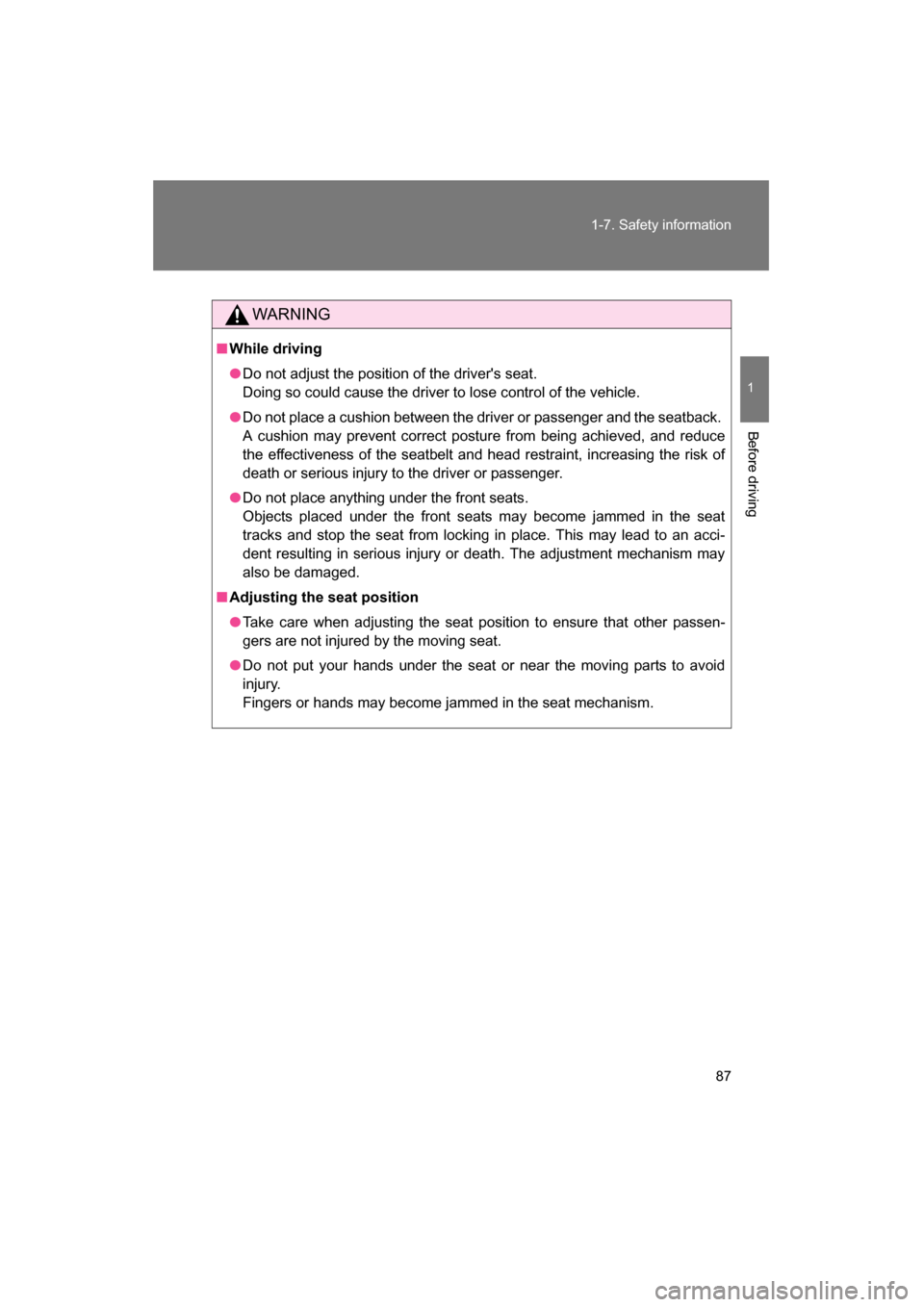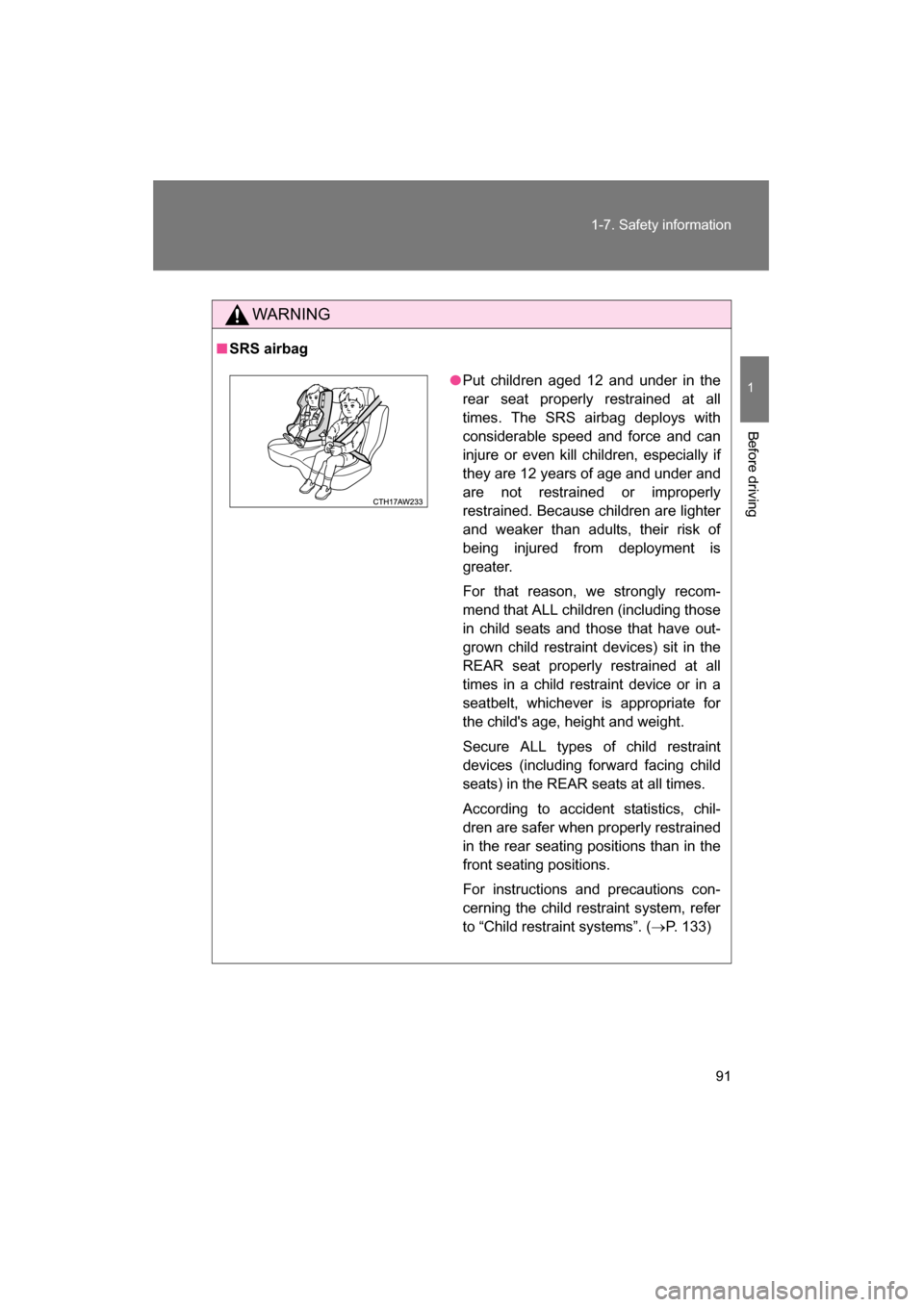Page 63 of 492
63
1-3. Adjustable components (seats, mirrors, steering wheel)
1
Before driving
WARNING
■People with a medical condition
Obtain medical advice and wear the seatbelt in the proper way.
■When children are in the vehicle
Do not allow children to play with the seatbelt. If the seatbelt becomes
twisted around a child’s neck, it may lead to choking or other serious injuries
that could result in death.
If this occurs and the buckle cannot be unfastened, scissors should be used
to cut the belt.
■Seatbelt pretensioners
If the pretensioner has activated, the SRS airbag system warning light will
come on. In that case, the seatbelt cannot be used again and must be
replaced at your SUBARU dealer.
Page 64 of 492

64
1-3. Adjustable components (seats, mirrors, steering wheel)
WARNING
■Seatbelt damage and wear
●Do not damage the seatbelts by allowing the belt, plate, or buckle to be
jammed in the door.
●Inspect the seatbelt system periodically. Check for cuts, fraying, and loose
parts. Replace a damaged seatbelt immediately. Damaged seatbelts can-
not protect an occupant from death or serious injury.
●Ensure that the belt and plate are locked and the belt is not twisted.
If the seatbelt does not function correctly, immediately contact your
SUBARU dealer.
●Replace the seat assembly, including the belts, if your vehicle has been
involved in a serious accident, even if there's no obvious damage.
●Do not attempt to install, remove, modify, disassemble or dispose of the
seatbelts. Have any necessary repairs carried out by your SUBARU
dealer. Inappropriate handling of the pretensioner may prevent it from
operating properly, resulting in death or serious injury.
■When using the seatbelt guide
●Always make sure that the belt is not twisted, and runs freely through the
guide.
●Regardless of whether the guide is used or not, always secure the seatbelt
guide button.
●Do not hang from or pull the guide forcefully.
■Before using the rear seatbelts
●Always make sure that the seatbelt is
not caught in the seatback or twisted in
one of the hooks that secure the seat-
back. Failure to do so may cause the
seatbelt to not be fastened correctly or
to become ineffective in a collision,
resulting in serious injury.
Page 86 of 492
86
1-7. Safety information
Correct driving posture
Drive with a good posture as follows:Sit upright and well back in
the seat. (→P. 5 1 )
Adjust the position of the
seat forward or backward to
ensure the pedals can be
reached and easily
depressed to the extent
required. ( →P. 51)
Adjust the seatback so that
the controls are easily oper-
able. ( →P. 5 1 )
Adjust the tilt and telescopic
positions of the steering
wheel to allow easy opera-
tion and to ensure the air-
bag is facing your chest. ( → P. 6 5 )
Lock the head restraint in
place with the center of the
head restraint closest to the
top of your ears. ( → P. 5 6 )
Wear the seatbelt correctly.( → P. 5 8 )
Page 87 of 492

87
1-7. Safety information
1
Before driving
WARNING
■While driving
●Do not adjust the position of the driver's seat.
Doing so could cause the driver to lose control of the vehicle.
●Do not place a cushion between the driver or passenger and the seatback.
A cushion may prevent correct posture from being achieved, and reduce
the effectiveness of the seatbelt and head restraint, increasing the risk of
death or serious injury to the driver or passenger.
●Do not place anything under the front seats.
Objects placed under the front seats may become jammed in the seat
tracks and stop the seat from locking in place. This may lead to an acci-
dent resulting in serious injury or death. The adjustment mechanism may
also be damaged.
■Adjusting the seat position
●Take care when adjusting the seat position to ensure that other passen-
gers are not injured by the moving seat.
●Do not put your hands under the seat or near the moving parts to avoid
injury.
Fingers or hands may become jammed in the seat mechanism.
Page 88 of 492
88
1-7. Safety information
SRS airbag (Supplemental Restraint System airbag)
The SRS airbags inflate when the vehicle is subjected to certain
types of severe impacts that may cause significant injury to the
occupants. They work together with the seatbelts to help reduce the
risk of death or serious injury.
SRS: This stands for supplemental restraint system. This name is
used because the airbag system supplements the vehicle’s seat-
belts.
Models with SRS airbags and shoulder restraints for driver,
front passenger, and window-side rear passengers
Your vehicle is equipped with a supplemental restraint system in
addition to a shoulder belt at each front seating position and each
rear window-side seating positions. The supplemental restraint
system (SRS) consists of six airbags. The configurations are as
follows.
Page 89 of 492
89
1-7. Safety information
1
Before driving
■When you sell your vehicle
When you sell your vehicle, we urge you to explain to the buyer that it is
equipped with SRS airbags by alerting the buyer to the applicable section in
this Owner’s Manual. Driver’s and front passenger’s frontal airbags
Driver’s and front passenger’s side airbags
Curtain airbags (for driver, front passenger, and window-side
rear passengers)
These SRS airbags are designed only as a supplement to the pri-
mary protection provided by the seatbelt.
The system also controls front seatbelt pretensioners. For opera-
tion instructions and precautions concerning the seatbelt preten-
sioner, refer to “Seatbelt pretensioners”. ( →P. 5 9 )
Page 90 of 492

90
1-7. Safety information
WARNING
■SRS airbag
●To obtain maximum protection in the event of an accident, the driver and
all passengers in the vehicle should always wear seatbelts when the vehi-
cle is moving. The SRS airbag is designed only to be a supplement to the
primary protection provided by the seatbelt. It does not eliminate the need
to fasten seatbelts. In combination with the seatbelts, it offers the best
combined protection in case of a serious accident.
Not wearing a seatbelt increases the chance of severe injury or death in a
crash even when the vehicle has the SRS airbag.
For instructions and precautions concerning the seatbelt system, refer to
“Seatbelts”. (→P. 58)
●Do not sit or lean unnecessarily close to the SRS airbag. Because the
SRS airbag deploys with considerable speed - faster than the blink of an
eye - and force to protect in high speed collisions, the force of an airbag
can injure an occupant whose body is too close to SRS airbag.
It is also important to wear your seatbelt to help avoid injuries that can
result when the SRS airbag contacts an occupant not in proper position
such as one thrown forward during pre-accident braking.
Even when properly positioned, there remains a possibility that an occu-
pant may suffer minor injury such as abrasions and bruises to the face or
arms because of the SRS airbag deployment force.
●The SRS airbags deploy with considerable speed and force. Occupants
who are out of proper position when the SRS airbag deploys could suffer
very serious injuries. Because the SRS airbag needs enough space for
deployment, the driver should always sit upright and well back in the seat
as far from the steering wheel as practical while still maintaining full vehi-
cle control and the front passenger should move the seat as far back as
possible and sit upright and well back in the seat.
●Do not place any objects over or near the SRS airbag cover or between
you and the SRS airbag. If the SRS airbag deploys, those objects could
interfere with its proper operation and could be propelled inside the vehicle
and cause injury.
Page 91 of 492

91
1-7. Safety information
1
Before driving
WARNING
■SRS airbag
●Put children aged 12 and under in the
rear seat properly restrained at all
times. The SRS airbag deploys with
considerable speed and force and can
injure or even kill children, especially if
they are 12 years of age and under and
are not restrained or improperly
restrained. Because children are lighter
and weaker than adults, their risk of
being injured from deployment is
greater.
For that reason, we strongly recom-
mend that ALL children (including those
in child seats and those that have out-
grown child restraint devices) sit in the
REAR seat properly restrained at all
times in a child restraint device or in a
seatbelt, whichever is appropriate for
the child's age, height and weight.
Secure ALL types of child restraint
devices (including forward facing child
seats) in the REAR seats at all times.
According to accident statistics, chil-
dren are safer when properly restrained
in the rear seating positions than in the
front seating positions.
For instructions and precautions con-
cerning the child restraint system, refer
to “Child restraint systems”. (→P. 133)